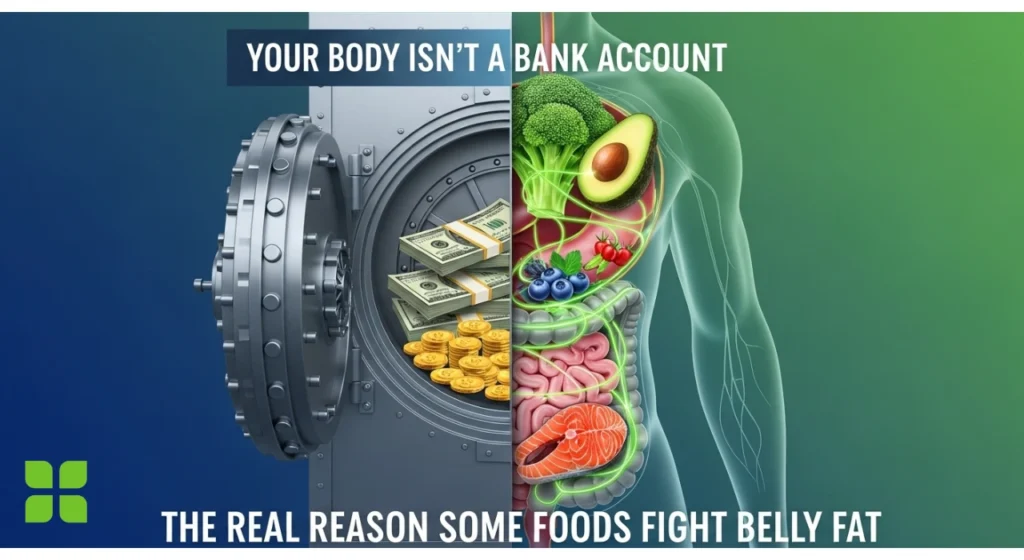Your Body Isn’t a Bank Account: The Real Reason Some Foods Fight Belly Fat

Let’s be honest. You’ve read the lists. The “Top 10 Foods to Blast Belly Fat.” They’re always there, sandwiched between celebrity gossip and ads for leggings. And while they aren’t necessarily wrong—yes, avocados and salmon are good for you—they miss the entire point. They treat your body like a simple machine where you put in “good food” and get out a “flat stomach.”
But your body is infinitely more complex. It’s a bustling, chaotic, and brilliant biological ecosystem run by hormones, signals, and feedback loops. Stubborn belly fat, particularly the dangerous visceral fat that settles around your organs, isn’t just a sign of excess calories. It’s a symptom of an ecosystem that’s out of whack.
So, what makes a food a true ally in this fight? It’s not about magic properties or exotic origins. It’s about how that food interacts with your body’s internal communication system. An effective “belly fat food” is less of a “superfood” and more of a master diplomat, excelling at a few critical jobs.
Table of Contents
Job #1: It’s a Professional Hunger Manager

The single biggest lie of dieting is that it’s all about willpower. It’s not. It’s about hunger. If your body is screaming for food, you will eventually eat. The trick is to hire foods that keep that screaming to a minimum. This is a two-person job handled by:
- Protein, the Foreman: Protein is demanding. Your body has to work significantly harder to digest it, burning more calories in the process. But its real talent is in signaling. Eating protein tells your brain, loud and clear, to shut down the “I’m starving” alerts. It’s the difference between a snack that tides you over for 30 minutes and a meal that leaves you satisfied and focused for hours.
- Fiber, the Traffic Cop: Specifically, soluble fiber. This isn’t just “roughage.” When you eat foods like beans, oats, or Brussels sprouts, this fiber mixes with water in your gut and creates a gel. It’s a natural speed bump for your entire digestive system. This slow-down gives your body time to register that it’s full and prevents the frantic energy swings that lead to desperate cravings later.
Job #2: It’s a Hormone Whisperer

Think of your “muffin top” as a physical manifestation of hormonal chaos. When you eat sugar and refined starches (white bread, pastries, soda), your blood sugar shoots up like a firework. Your body panics and floods your system with the hormone insulin to control the situation. Insulin’s emergency protocol? Shove that excess sugar into storage—and its favorite storage unit is your midsection.
A true fat-fighting food is a hormone whisperer. It releases its energy slowly and calmly, like a gentle conversation instead of a shout. It keeps blood sugar stable, which means insulin doesn’t have to come out with sirens blazing. This promotes a state of hormonal peace, encouraging your body to burn its stored fat for energy instead of frantically storing more.
Job #3: It’s an Internal Firefighter

We all know what inflammation looks like on the outside—a red, swollen ankle. But inside our bodies, a low-grade, chronic inflammation can be smoldering for years. This internal static, often fueled by stress, poor sleep, and processed foods, disrupts communication between our cells and is a known accomplice in the storage of visceral fat.
This is where the real “superfoods” earn their keep. They are internal firefighters. The potent Omega-3s in fatty fish, the deep, rich colors of berries, the earthy power of leafy greens like kale and spinach—these are all packed with antioxidants and compounds that douse those inflammatory embers. They aren’t just “healthy”; they are actively creating a calmer, more balanced internal environment that is less prone to holding onto fat.
So, the next time you’re building your plate, stop thinking about a simple tally of calories. Instead, look at your food and ask what job it’s going to do. Will it manage your hunger? Will it soothe your hormones? Will it calm the internal fire?
When you start hiring foods for these crucial roles, you stop “dieting” and start managing your body’s ecosystem. And that is the most powerful, and human, way to win the fight.








